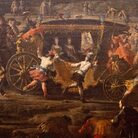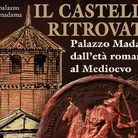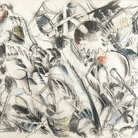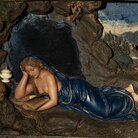Tom Herck. Once We Ruled the World

Tom Herck. Once We Ruled the World, Venice
Dal 20 April 2024 al 24 November 2024
Venezia
Luogo: Palazzo Balbi Valier
Indirizzo: Piscina del Forner 866
On the occasion of the 60th Venice Art Biennale (2024), Belgian contemporary artist Tom Herck presents a new and unique monumental work in the garden of Palazzo Balbi Valier - visible from the Gran Canale and the Ponte de l'Accademia.
Once We Ruled the World depicts the interaction between giant human skeletons and full-size dinosaur skeletons, interacting with the Gran Canale. The Biennale will run from 20 April 2024 to 24 November 2024.
The extinction of non-avian dinosaurs occurred around 66 million years ago due to a cataclysmic event, making way for mammals and eventually the evolution of humans. Despite lacking physical prowess comparable to carnivorous dinosaurs, humans have become apex predators through their advanced cognitive abilities, intricate tools, and complex social structures. This has allowed them to dominate the Earth, but it has also led to a sense of superiority above nature's laws.
Once We Ruled the World shows a series of monumental installations featuring giant human skeletons alongside life-size dinosaur skeletons metaphorically emphasize human ego and vanity. While humans and dinosaurs never coexisted, the enduring fascination with dinosaurs explores themes of extinction, evolution, and the passage of time.
This monumental installation – 10 meters high in total – serves as a cautionary reminder of the impermanence of power and the cyclical nature of history, prompting reflection on the rise and fall of civilizations, or species, that once dominated the planet for prolonged periods.
Once We Ruled The World will be on display in the gardens of Castle of Ordingen from the end of February to the end of March 2024, but in this position it was designed specifically for Venice. The work makes a deep connection to Venice's rich history and that of humanity as a whole, playfully questioning our relationship to it. The installation will be on display in the garden of Palazzo Balbi Valier, a hotspot with excellent location - right at a central hub for tourists and art lovers on the Gran Canale - and engages directly with the canal.
Adjacent to the installation, a conspicuous QR code beckons the technologically inclined. The QR code, once scanned, unveils an Augmented Reality (AR) app, fostering an interactive dialogue between the spectators and the installation. This AR extension alludes to the ongoing digital revolution and the trajectory of human progress. In addition, through the application of black light paint, the installation's transformation into an X-ray-like manifestation unfolds during the twilight hours.
In conjunction with the 60th International Art Exhibition of the Venice Biennale - BiennaleArte 2024, set to unfold from Saturday, April 20 to Sunday, November 24, 2024, thedistinguished Belgian contemporary artist, Tom Herck, unveils his avant-garde public artinstallation, "Once We Ruled the World." Gracing the serene Garden of Palazzo Balbi Valier,this installation asserts a compelling presence, visible from the historic Grand Canal inVenice, Italy.
The focal point of this installation, "Once We Ruled the World," stands as a monumental testament to Herck's artistic prowess, featuring a skeletal sculpture that stretches to an imposing height. This sculptural marvel symbolizes the intricate relationship between humans and the bygone era of dinosaurs, igniting a reflective discourse on our historical connections, ecological impact, and the nuanced aspects of human vanity.
Echoing Herck's insightful perspective, the work masterfully captures the essence of Venice as a city teetering between its glorious past and an uncertain future. With a profound resonance to the theme of transience, the installation serves as a poignant 'Memento Mori,' echoing the city's his-torical struggle with existential threats that swept through Venice during the historic plagues.
The installation, in its symbolic representation, bridges the gap between the past and the present, inviting viewers to contemplate Venice's enduring spirit and its ability to navigate the uncertainties through time. Through this majestic representation, Herck probes the dualistic nature of humanity'sexistence as both guardians and conquerors of ancient life, challenging viewers to contemplate our role in the continuum of time and our influence on Earth's future. His work, steeped in themes of dominion and existential cycles, resonates profoundly with the Biennale's thematic explorations, positioning itself as a bold and introspective commentary on the evolution of human interaction with the natural world.
Herck's artistic endeavor seamlessly integrates the tangible realm of sculpture with the immersive world of artificial reality (AR), offering an interactive experience accessible through a visible QR code. This innovative approach not only enhances the physicality of the sculpture but also invites the audience into a multi-layered experiential journey, melding traditional art forms with digital interactivity."Once We Ruled the World" is not merely an artistic expression; it is a conduit for introspection and dialogue.
By bridging the past with the present, Herck's installation invites us to ponder our collective responsibilities and the legacy we leave behind, firmly establishing his installation as a landmark contribution to the Venice Biennale 2024.
In conclusion, Tom Herck's contribution to the Venice Biennale is not just an exhibition of extraordinary art; it is an invitation to a profound exploration of history, mortality, and the human journey. His installations, a powerful medium for reflection and dialogue, underscore his ability to inspire and shape our collective future. Herck's work, embedded with a deep commitment to societal reflection and discourse, positions him as a significant voice in contemporary art, continually exploring new narratives and challenging boundaries with diverse and unconventional mediums. “
Once We Ruled the World depicts the interaction between giant human skeletons and full-size dinosaur skeletons, interacting with the Gran Canale. The Biennale will run from 20 April 2024 to 24 November 2024.
The extinction of non-avian dinosaurs occurred around 66 million years ago due to a cataclysmic event, making way for mammals and eventually the evolution of humans. Despite lacking physical prowess comparable to carnivorous dinosaurs, humans have become apex predators through their advanced cognitive abilities, intricate tools, and complex social structures. This has allowed them to dominate the Earth, but it has also led to a sense of superiority above nature's laws.
Once We Ruled the World shows a series of monumental installations featuring giant human skeletons alongside life-size dinosaur skeletons metaphorically emphasize human ego and vanity. While humans and dinosaurs never coexisted, the enduring fascination with dinosaurs explores themes of extinction, evolution, and the passage of time.
This monumental installation – 10 meters high in total – serves as a cautionary reminder of the impermanence of power and the cyclical nature of history, prompting reflection on the rise and fall of civilizations, or species, that once dominated the planet for prolonged periods.
Once We Ruled The World will be on display in the gardens of Castle of Ordingen from the end of February to the end of March 2024, but in this position it was designed specifically for Venice. The work makes a deep connection to Venice's rich history and that of humanity as a whole, playfully questioning our relationship to it. The installation will be on display in the garden of Palazzo Balbi Valier, a hotspot with excellent location - right at a central hub for tourists and art lovers on the Gran Canale - and engages directly with the canal.
Adjacent to the installation, a conspicuous QR code beckons the technologically inclined. The QR code, once scanned, unveils an Augmented Reality (AR) app, fostering an interactive dialogue between the spectators and the installation. This AR extension alludes to the ongoing digital revolution and the trajectory of human progress. In addition, through the application of black light paint, the installation's transformation into an X-ray-like manifestation unfolds during the twilight hours.
In conjunction with the 60th International Art Exhibition of the Venice Biennale - BiennaleArte 2024, set to unfold from Saturday, April 20 to Sunday, November 24, 2024, thedistinguished Belgian contemporary artist, Tom Herck, unveils his avant-garde public artinstallation, "Once We Ruled the World." Gracing the serene Garden of Palazzo Balbi Valier,this installation asserts a compelling presence, visible from the historic Grand Canal inVenice, Italy.
The focal point of this installation, "Once We Ruled the World," stands as a monumental testament to Herck's artistic prowess, featuring a skeletal sculpture that stretches to an imposing height. This sculptural marvel symbolizes the intricate relationship between humans and the bygone era of dinosaurs, igniting a reflective discourse on our historical connections, ecological impact, and the nuanced aspects of human vanity.
Echoing Herck's insightful perspective, the work masterfully captures the essence of Venice as a city teetering between its glorious past and an uncertain future. With a profound resonance to the theme of transience, the installation serves as a poignant 'Memento Mori,' echoing the city's his-torical struggle with existential threats that swept through Venice during the historic plagues.
The installation, in its symbolic representation, bridges the gap between the past and the present, inviting viewers to contemplate Venice's enduring spirit and its ability to navigate the uncertainties through time. Through this majestic representation, Herck probes the dualistic nature of humanity'sexistence as both guardians and conquerors of ancient life, challenging viewers to contemplate our role in the continuum of time and our influence on Earth's future. His work, steeped in themes of dominion and existential cycles, resonates profoundly with the Biennale's thematic explorations, positioning itself as a bold and introspective commentary on the evolution of human interaction with the natural world.
Herck's artistic endeavor seamlessly integrates the tangible realm of sculpture with the immersive world of artificial reality (AR), offering an interactive experience accessible through a visible QR code. This innovative approach not only enhances the physicality of the sculpture but also invites the audience into a multi-layered experiential journey, melding traditional art forms with digital interactivity."Once We Ruled the World" is not merely an artistic expression; it is a conduit for introspection and dialogue.
By bridging the past with the present, Herck's installation invites us to ponder our collective responsibilities and the legacy we leave behind, firmly establishing his installation as a landmark contribution to the Venice Biennale 2024.
In conclusion, Tom Herck's contribution to the Venice Biennale is not just an exhibition of extraordinary art; it is an invitation to a profound exploration of history, mortality, and the human journey. His installations, a powerful medium for reflection and dialogue, underscore his ability to inspire and shape our collective future. Herck's work, embedded with a deep commitment to societal reflection and discourse, positions him as a significant voice in contemporary art, continually exploring new narratives and challenging boundaries with diverse and unconventional mediums. “
SCARICA IL COMUNICATO IN PDF
COMMENTI

-
 Dal 20 December 2025 al 20 April 2026
Caserta | Reggia di Caserta
Dal 20 December 2025 al 20 April 2026
Caserta | Reggia di Caserta
Regine: trame di cultura e diplomazia tra Napoli e l’Europa
-
 Dal 19 December 2025 al 23 March 2026
Torino | Palazzo Madama - Museo Civico d’Arte Antica
Dal 19 December 2025 al 23 March 2026
Torino | Palazzo Madama - Museo Civico d’Arte Antica
Il castello ritrovato. Palazzo Madama dall’età romana al medioevo
-
 Dal 17 December 2025 al 19 January 2026
Roma | Palazzo della Cancelleria
Dal 17 December 2025 al 19 January 2026
Roma | Palazzo della Cancelleria
De Humana Mensura di Linda Karshan
-
 Dal 18 December 2025 al 12 April 2026
Firenze | Gallerie degli Uffizi
Dal 18 December 2025 al 12 April 2026
Firenze | Gallerie degli Uffizi
Cera una volta. Sculture dalle collezioni medicee
-
 Dal 11 December 2025 al 9 April 2026
Firenze | Museo Archeologico Nazionale di Firenze
Dal 11 December 2025 al 9 April 2026
Firenze | Museo Archeologico Nazionale di Firenze
Icone di Potere e Bellezza
-
 Dal 11 December 2025 al 11 January 2026
Roma | Palazzo Esposizioni Roma
Dal 11 December 2025 al 11 January 2026
Roma | Palazzo Esposizioni Roma
Giorgio Morandi nella Collezione Eni. Un viaggio attraverso la storia culturale del cane a sei zampe e l’eredità di Enrico Mattei


